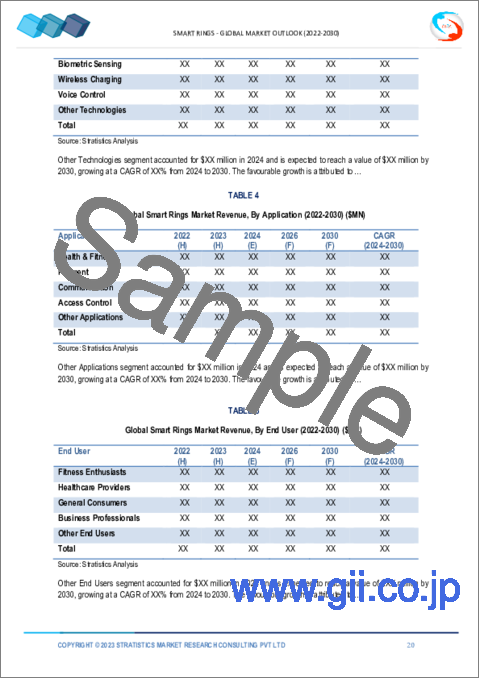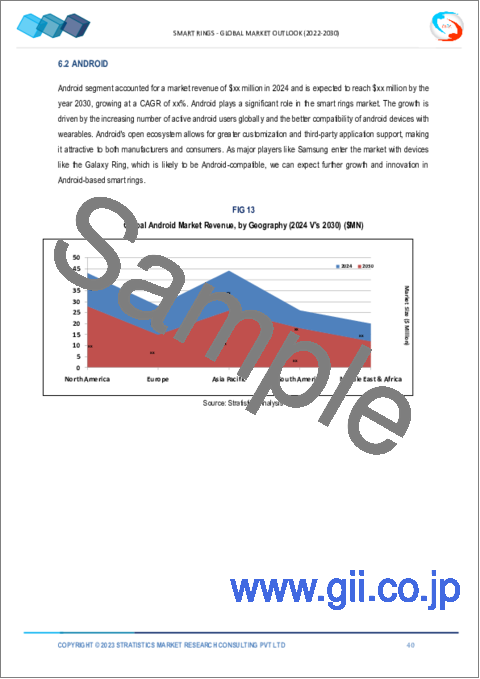|
|
市場調査レポート
商品コード
1503384
スマートリング市場の2030年までの予測: 材料、オペレーティングシステム、技術、用途、エンドユーザー、地域別の世界分析Smart Rings Market Forecasts to 2030 - Global Analysis By Material (Metal, Plastic, Ceramic, Composite Materials and Other Materials), Operating System, Technology, Application, End User and By Geography |
||||||
カスタマイズ可能
|
|||||||
| スマートリング市場の2030年までの予測: 材料、オペレーティングシステム、技術、用途、エンドユーザー、地域別の世界分析 |
|
出版日: 2024年06月06日
発行: Stratistics Market Research Consulting
ページ情報: 英文 200+ Pages
納期: 2~3営業日
|
全表示
- 概要
- 図表
- 目次
Stratistics MRCによると、スマートリングの世界市場は2024年に2,005万米ドルを占め、予測期間中のCAGRは30.9%で成長し、2030年には1億9,065万米ドルに達する見込みです。
スマートリングは、先進技術をコンパクトな指輪の形に統合したウェアラブルデバイスです。一般的に、リングに埋め込まれたセンサーや小型部品を通じて、フィットネストラッキング、通知、モバイル決済などの機能を提供します。スマートリングはファッション性と機能性を兼ね備えており、ユーザーの指から直接アクセスできる、控えめながら強力なデジタル機能の拡張を提供します。コンパクトなウェアラブルデバイスに利便性、接続性、スタイルを求める個人を対象としています。
個人の健康とフィットネスへの関心の高まり
生体センサーを搭載したスマートリングは、心拍数、睡眠パターン、活動レベルなどの指標を追跡することができ、ユーザーに貴重な健康に関する洞察を提供します。消費者の健康意識が高まるにつれ、便利でリアルタイムの健康追跡ソリューションを求めるようになり、スマートリングは魅力的な選択肢となっています。この動向は、デジタルヘルス技術の採用拡大によって増幅され、人々が積極的な健康管理を優先するようになり、市場拡大にさらに拍車をかけています。
限られたバッテリー寿命
スマートリングの電池寿命が限られているのは、そのコンパクトなサイズによるもので、大型の電池や高度な電力管理システムに利用できるスペースが制限されています。このため、頻繁に充電する必要があり、ユーザーがウェアラブル端末に期待する利便性や継続的な機能性が低下します。その結果、消費者の満足度が低下し、普及率の低下につながる可能性があります。潜在的な購買層が頻繁な充電の不便さに敬遠し、市場成長の妨げになる可能性もあります。
企業のウェルネス・プログラムの増加
従業員の健康、生産性、エンゲージメントを高めるため、ウェルネス・プログラムを導入する企業が増えています。フィットネス、睡眠、ストレスレベルをモニターできるスマートリングは、こうしたプログラムをサポートする貴重なデータを提供します。組織が健康追跡のためにウェアラブル技術に投資するにつれて、スマートリングの需要は増加しています。この動向は売上を押し上げるだけでなく、企業のウェルネス戦略の具体的なニーズに対応し、市場のさらなる革新を促します。
互換性の問題
スマートリングの互換性の問題は、さまざまなスマートフォン、オペレーティングシステム、その他のスマートデバイスとシームレスに統合する必要性から生じる。互換性が一貫していなかったり、限定的であったりすると、ユーザーエクスペリエンスが分断され、スマートリングの魅力が低下する可能性があります。ユーザーはデータの同期や機能へのアクセスで困難に直面する可能性があり、デバイスの全体的な実用性が低下します。こうした課題は潜在的な購買意欲を削ぎ、普及率を低下させ、市場の成長を妨げる可能性があります。
COVID-19の影響
COVID-19のパンデミックは、サプライチェーンの混乱と非必需品への消費支出の減少により、当初はスマートリング市場を減速させました。しかし、健康モニタリングと非接触技術の重視により、フィットネス・トラッキングと健康指標を提供するスマートリングの需要が高まった。この遠隔健康モニタリングと非接触決済へのシフトは、消費者が個人の健康管理を強化し、取引における物理的接触を減らすことができるウェアラブルデバイスを求めたため、パンデミック後の市場成長を加速させました。
予測期間中、ヘルス&フィットネス分野が最大になる見込み
健康&フィットネス分野は、有利な成長を遂げると推定されます。スマートリングは革新的な健康・フィットネスツールとして登場し、心拍数、睡眠パターン、活動レベルなどのバイタルサインの目立たないモニタリングを提供しています。これらのウェアラブルデバイスは日常生活にシームレスに溶け込み、フィットネスの進捗状況や全体的な健康状態の把握に役立つリアルタイムのデータや洞察を提供します。ストレス管理や睡眠の質分析などの機能を備えたスマートリングは、ユーザーが自分の健康について十分な情報を得た上で意思決定できるようにし、個人のフィットネス目標に対する積極的なアプローチを促進します。
予測期間中、フィットネス愛好家セグメントのCAGRが最も高くなると予測される
フィットネス愛好家セグメントは、予測期間中に最も速いCAGR成長を示すと予測されています。スマートリングは、重要な健康指標を目立たないようにモニタリングできることから、フィットネス愛好家の間で人気が高まっています。これらのウェアラブルデバイスは、心拍数、消費カロリー、睡眠の質などの指標を追跡し、リアルタイムデータと実用的な洞察を提供します。ウェアラブルデバイスは、先進技術の統合によってフィットネス体験全体を向上させる、パーソナル・ヘルス・アシスタントの役割を果たしています。
最大のシェアを持つ地域
アジア太平洋地域のスマートリング市場は、技術の進歩、健康とフィットネスに対する消費者の意識の高まり、可処分所得の増加によって大きな成長を遂げています。中国、日本、韓国のような国々は、技術に精通した人口と強力な製造能力により、採用をリードしています。人口が多く都市化が進むアジア太平洋地域は、スマートリング技術の今後の拡大にとって重要な地域です。
CAGRが最も高い地域:
北米では、ウェアラブル技術の消費者普及率が高く、技術に精通した人口が多いため、スマートリング市場が活況を呈しています。米国とカナダは、スマートリングが提供するフィットネストラッキング、健康モニタリング、非接触決済機能に対する需要に牽引され、市場成長をリードしています。この地域の企業は、生体認証センサーやスマートホームシステムとの統合といった先進的な機能で革新を進め、健康志向の消費者に対応しています。ハイテク企業とヘルスケアプロバイダーのパートナーシップも市場拡大を後押ししており、北米はスマートリングの開発と普及の重要な拠点となっています。
無料のカスタマイズサービス:
本レポートをご購読のお客様には、以下の無料カスタマイズオプションのいずれかをご利用いただけます:
- 企業プロファイル
- 追加市場プレイヤーの包括的プロファイリング(3社まで)
- 主要企業のSWOT分析(3社まで)
- 地域セグメンテーション
- 顧客の関心に応じた主要国の市場推計・予測・CAGR(注:フィージビリティチェックによる)
- 競合ベンチマーキング
- 製品ポートフォリオ、地理的プレゼンス、戦略的提携に基づく主要企業のベンチマーキング
目次
第1章 エグゼクティブサマリー
第2章 序文
- 概要
- ステークホルダー
- 調査範囲
- 調査手法
- データマイニング
- データ分析
- データ検証
- 調査アプローチ
- 調査情報源
- 1次調査情報源
- 2次調査情報源
- 前提条件
第3章 市場動向分析
- 促進要因
- 抑制要因
- 機会
- 脅威
- 技術分析
- 用途分析
- エンドユーザー分析
- 新興市場
- COVID-19の影響
第4章 ポーターのファイブフォース分析
- 供給企業の交渉力
- 買い手の交渉力
- 代替品の脅威
- 新規参入業者の脅威
- 競争企業間の敵対関係
第5章 世界のスマートリング市場:材料別
- 金属
- プラスチック
- セラミック
- 複合材料
- その他の材料
第6章 世界のスマートリング市場:オペレーティングシステム別
- Android
- iPhoneオペレーティングシステム(iOS)
- Windows
- 独自のオペレーティングシステム
- OSなし/組み込みシステム
- 混合互換性
第7章 世界のスマートリング市場:技術別
- NFC(近距離無線通信)
- ブルートゥース
- ジェスチャーコントロール
- 生体認証センシング
- ワイヤレス充電
- 音声コントロール
- その他のテクノロジー
第8章 世界のスマートリング市場:用途別
- ヘルス&フィットネス
- 決済
- 通信
- アクセス制御
- その他の用途
第9章 世界のスマートリング市場:エンドユーザー別
- フィットネス愛好家
- ヘルスケア提供者
- 一般消費者
- ビジネスプロフェッショナル
- その他のエンドユーザー
第10章 世界のスマートリング市場:地域別
- 北米
- 米国
- カナダ
- メキシコ
- 欧州
- ドイツ
- 英国
- イタリア
- フランス
- スペイン
- その他欧州
- アジア太平洋地域
- 日本
- 中国
- インド
- オーストラリア
- ニュージーランド
- 韓国
- その他アジア太平洋地域
- 南米
- アルゼンチン
- ブラジル
- チリ
- その他南米
- 中東・アフリカ
- サウジアラビア
- アラブ首長国連邦
- カタール
- 南アフリカ
- その他中東とアフリカ
第11章 主な発展
- 契約、パートナーシップ、コラボレーション、合弁事業
- 買収と合併
- 新製品発売
- 事業拡大
- その他の主要戦略
第12章 企業プロファイリング
- Samsung
- Noise
- Oura Health Limited
- Motiv
- Fujitsu Limited
- McLEAR
- Mota
- Jakcom Technology
- Ringly Inc.
- Nod Ring
- RHL Vision Technologies
- Moodmetric
- Kerv
- Vinaya
- ORII
List of Tables
- Table 1 Global Smart Rings Market Outlook, By Region (2022-2030) ($MN)
- Table 2 Global Smart Rings Market Outlook, By Material (2022-2030) ($MN)
- Table 3 Global Smart Rings Market Outlook, By Metal (2022-2030) ($MN)
- Table 4 Global Smart Rings Market Outlook, By Plastic (2022-2030) ($MN)
- Table 5 Global Smart Rings Market Outlook, By Ceramic (2022-2030) ($MN)
- Table 6 Global Smart Rings Market Outlook, By Composite Materials (2022-2030) ($MN)
- Table 7 Global Smart Rings Market Outlook, By Other Materials (2022-2030) ($MN)
- Table 8 Global Smart Rings Market Outlook, By Operating System (2022-2030) ($MN)
- Table 9 Global Smart Rings Market Outlook, By Android (2022-2030) ($MN)
- Table 10 Global Smart Rings Market Outlook, By iPhone Operating System (iOS) (2022-2030) ($MN)
- Table 11 Global Smart Rings Market Outlook, By Windows (2022-2030) ($MN)
- Table 12 Global Smart Rings Market Outlook, By Proprietary Operating Systems (2022-2030) ($MN)
- Table 13 Global Smart Rings Market Outlook, By No OS / Embedded Systems (2022-2030) ($MN)
- Table 14 Global Smart Rings Market Outlook, By Mixed Compatibility (2022-2030) ($MN)
- Table 15 Global Smart Rings Market Outlook, By Technology (2022-2030) ($MN)
- Table 16 Global Smart Rings Market Outlook, By NFC (Near Field Communication) (2022-2030) ($MN)
- Table 17 Global Smart Rings Market Outlook, By Bluetooth (2022-2030) ($MN)
- Table 18 Global Smart Rings Market Outlook, By Gesture Control (2022-2030) ($MN)
- Table 19 Global Smart Rings Market Outlook, By Biometric Sensing (2022-2030) ($MN)
- Table 20 Global Smart Rings Market Outlook, By Wireless Charging (2022-2030) ($MN)
- Table 21 Global Smart Rings Market Outlook, By Voice Control (2022-2030) ($MN)
- Table 22 Global Smart Rings Market Outlook, By Other Technologies (2022-2030) ($MN)
- Table 23 Global Smart Rings Market Outlook, By Application (2022-2030) ($MN)
- Table 24 Global Smart Rings Market Outlook, By Health & Fitness (2022-2030) ($MN)
- Table 25 Global Smart Rings Market Outlook, By Payment (2022-2030) ($MN)
- Table 26 Global Smart Rings Market Outlook, By Communication (2022-2030) ($MN)
- Table 27 Global Smart Rings Market Outlook, By Access Control (2022-2030) ($MN)
- Table 28 Global Smart Rings Market Outlook, By Other Applications (2022-2030) ($MN)
- Table 29 Global Smart Rings Market Outlook, By End User (2022-2030) ($MN)
- Table 30 Global Smart Rings Market Outlook, By Fitness Enthusiasts (2022-2030) ($MN)
- Table 31 Global Smart Rings Market Outlook, By Healthcare Providers (2022-2030) ($MN)
- Table 32 Global Smart Rings Market Outlook, By General Consumers (2022-2030) ($MN)
- Table 33 Global Smart Rings Market Outlook, By Business Professionals (2022-2030) ($MN)
- Table 34 Global Smart Rings Market Outlook, By Other End Users (2022-2030) ($MN)
Note: Tables for North America, Europe, APAC, South America, and Middle East & Africa Regions are also represented in the same manner as above.
According to Stratistics MRC, the Global Smart Rings Market is accounted for $20.05 million in 2024 and is expected to reach $190.65 million by 2030 growing at a CAGR of 30.9% during the forecast period. Smart rings are wearable devices that integrate advanced technology into a compact ring form. They typically offer functionalities such as fitness tracking, notifications, and mobile payments through sensors and miniature components embedded within the ring. Smart rings combine fashion with functionality, providing a discreet yet powerful extension of digital capabilities directly accessible from the user's finger. They cater to individuals seeking convenience, connectivity, and style in a compact wearable device.
Market Dynamics:
Driver:
Increasing focus on personal health and fitness
Smart rings equipped with biometric sensors can track metrics like heart rate, sleep patterns, and activity levels, providing users with valuable health insights. As consumers become more health-conscious, they seek convenient, real-time health tracking solutions, making smart rings an attractive option. This trend is amplified by the growing adoption of digital health technologies, further fuelling market expansion as people prioritize proactive health management.
Restraint:
Limited battery life
Limited battery life in smart rings is due to their compact size, which restricts the space available for larger batteries and advanced power management systems. This necessitates frequent recharging, reducing the convenience and continuous functionality users expect from wearable devices. As a result, consumer satisfaction may decrease, leading to lower adoption rates. Potential buyers might be deterred by the inconvenience of frequent charging, thus hampering market growth.
Opportunity:
Rising corporate wellness programs
Companies are increasingly adopting wellness programs to enhance employee health, productivity, and engagement. Smart rings, with their ability to monitor fitness, sleep, and stress levels, offer valuable data that supports these programs. As organizations invest in wearable technology for health tracking, demand for smart rings increases. This trend not only boosts sales but also encourages further innovation in the market, catering to the specific needs of corporate wellness strategies.
Threat:
Compatibility issues
Compatibility issues in smart rings arise from their need to seamlessly integrate with various smartphones, operating systems, and other smart devices. Inconsistent or limited compatibility can lead to a fragmented user experience, reducing the appeal of smart rings. Users may face difficulties in syncing data or accessing features, which diminishes the device's overall utility. These challenges can deter potential buyers, slow adoption rates, and hinder market growth.
Covid-19 Impact
The covid-19 pandemic initially slowed the smart rings market due to disrupted supply chains and reduced consumer spending on non-essential goods. However, the emphasis on health monitoring and contactless technologies boosted demand for smart rings that offer fitness tracking and health metrics. This shift towards remote health monitoring and contactless payments accelerated market growth post-pandemic, as consumers sought wearable devices that could enhance personal health management and reduce physical contact in transactions.
The health & fitness segment is expected to be the largest during the forecast period
The health & fitness segment is estimated to have a lucrative growth. Smart rings have emerged as innovative health and fitness tools, offering discreet monitoring of vital signs such as heart rate, sleep patterns, and activity levels. These wearable devices seamlessly integrate into daily life, providing real-time data and insights that help users track their fitness progress and overall well-being. With features like stress management and sleep quality analysis, smart rings empower users to make informed decisions about their health, promoting a proactive approach to personal fitness goals.
The fitness enthusiasts segment is expected to have the highest CAGR during the forecast period
The fitness enthusiasts segment is anticipated to witness the fastest CAGR growth during the forecast period. Smart rings are becoming increasingly popular among fitness enthusiasts for their ability to monitor vital health metrics discreetly. These wearable devices track metrics such as heart rate, calories burned, and sleep quality, providing real-time data and actionable insights. They serve as personal health assistants, enhancing the overall fitness experience through advanced technology integration.
Region with largest share:
The smart rings market in the Asia Pacific region is experiencing significant growth driven by technological advancements, increasing consumer awareness about health and fitness, and rising disposable incomes. Countries like China, Japan, and South Korea are leading the adoption due to their tech-savvy populations and strong manufacturing capabilities. With a large population and increasing urbanization, Asia Pacific remains a key region for the future expansion of smart ring technologies.
Region with highest CAGR:
In North America, the smart rings market is thriving due to high consumer adoption of wearable technology and a tech-savvy population. The United States and Canada lead in market growth, driven by demand for fitness tracking, health monitoring, and contactless payment capabilities offered by smart rings. Companies in the region are innovating with advanced features like biometric sensors and integration with smart home systems, catering to health-conscious consumers. Partnerships between tech firms and healthcare providers also bolster market expansion, making North America a key hub for smart ring development and adoption.
Key players in the market
Some of the key players profiled in the Smart Rings Market include Samsung, Noise, Oura Health Limited, Motiv, Fujitsu Limited, McLEAR, Mota, Jakcom Technology, Ringly Inc., Nod Ring, RHL Vision Technologies, Moodmetric, Kerv, Vinaya and ORII.
Key Developments:
In February 2024, Samsung announced that they will launch the Galaxy Ring in the second half of 2024. Samsung Health users will likely be able to connect the Galaxy Watch with the Galaxy Ring for more accurate fitness tracking.
In August 2023, Noise launched Luna Ring, a premium smart ring with a titanium body. The ring is capable of tracking over 70 health metrics, include heart rate, temperature and SpO2 levels. The Luna Ring is compatible with both, Android and iOS devices and comes with a 7-day battery life.
Materials Covered:
- Metal
- Plastic
- Ceramic
- Composite Materials
- Other Materials
Operating Systems Covered:
- Android
- iPhone Operating System (iOS)
- Windows
- Proprietary Operating Systems
- No OS / Embedded Systems
- Mixed Compatibility
Technologies Covered:
- NFC (Near Field Communication)
- Bluetooth
- Gesture Control
- Biometric Sensing
- Wireless Charging
- Voice Control
- Other Technologies
Applications Covered:
- Health & Fitness
- Payment
- Communication
- Access Control
- Other Applications
End Users Covered:
- Fitness Enthusiasts
- Healthcare Providers
- General Consumers
- Business Professionals
- Other End Users
Regions Covered:
- North America
- US
- Canada
- Mexico
- Europe
- Germany
- UK
- Italy
- France
- Spain
- Rest of Europe
- Asia Pacific
- Japan
- China
- India
- Australia
- New Zealand
- South Korea
- Rest of Asia Pacific
- South America
- Argentina
- Brazil
- Chile
- Rest of South America
- Middle East & Africa
- Saudi Arabia
- UAE
- Qatar
- South Africa
- Rest of Middle East & Africa
What our report offers:
- Market share assessments for the regional and country-level segments
- Strategic recommendations for the new entrants
- Covers Market data for the years 2022, 2023, 2024, 2026, and 2030
- Market Trends (Drivers, Constraints, Opportunities, Threats, Challenges, Investment Opportunities, and recommendations)
- Strategic recommendations in key business segments based on the market estimations
- Competitive landscaping mapping the key common trends
- Company profiling with detailed strategies, financials, and recent developments
- Supply chain trends mapping the latest technological advancements
Free Customization Offerings:
All the customers of this report will be entitled to receive one of the following free customization options:
- Company Profiling
- Comprehensive profiling of additional market players (up to 3)
- SWOT Analysis of key players (up to 3)
- Regional Segmentation
- Market estimations, Forecasts and CAGR of any prominent country as per the client's interest (Note: Depends on feasibility check)
- Competitive Benchmarking
- Benchmarking of key players based on product portfolio, geographical presence, and strategic alliances
Table of Contents
1 Executive Summary
2 Preface
- 2.1 Abstract
- 2.2 Stake Holders
- 2.3 Research Scope
- 2.4 Research Methodology
- 2.4.1 Data Mining
- 2.4.2 Data Analysis
- 2.4.3 Data Validation
- 2.4.4 Research Approach
- 2.5 Research Sources
- 2.5.1 Primary Research Sources
- 2.5.2 Secondary Research Sources
- 2.5.3 Assumptions
3 Market Trend Analysis
- 3.1 Introduction
- 3.2 Drivers
- 3.3 Restraints
- 3.4 Opportunities
- 3.5 Threats
- 3.6 Technology Analysis
- 3.7 Application Analysis
- 3.8 End User Analysis
- 3.9 Emerging Markets
- 3.10 Impact of Covid-19
4 Porters Five Force Analysis
- 4.1 Bargaining power of suppliers
- 4.2 Bargaining power of buyers
- 4.3 Threat of substitutes
- 4.4 Threat of new entrants
- 4.5 Competitive rivalry
5 Global Smart Rings Market, By Material
- 5.1 Introduction
- 5.2 Metal
- 5.3 Plastic
- 5.4 Ceramic
- 5.5 Composite Materials
- 5.6 Other Materials
6 Global Smart Rings Market, By Operating System
- 6.1 Introduction
- 6.2 Android
- 6.3 iPhone Operating System (iOS)
- 6.4 Windows
- 6.5 Proprietary Operating Systems
- 6.6 No OS / Embedded Systems
- 6.7 Mixed Compatibility
7 Global Smart Rings Market, By Technology
- 7.1 Introduction
- 7.2 NFC (Near Field Communication)
- 7.3 Bluetooth
- 7.4 Gesture Control
- 7.5 Biometric Sensing
- 7.6 Wireless Charging
- 7.7 Voice Control
- 7.8 Other Technologies
8 Global Smart Rings Market, By Application
- 8.1 Introduction
- 8.2 Health & Fitness
- 8.3 Payment
- 8.4 Communication
- 8.5 Access Control
- 8.6 Other Applications
9 Global Smart Rings Market, By End User
- 9.1 Introduction
- 9.2 Fitness Enthusiasts
- 9.3 Healthcare Providers
- 9.4 General Consumers
- 9.5 Business Professionals
- 9.6 Other End Users
10 Global Smart Rings Market, By Geography
- 10.1 Introduction
- 10.2 North America
- 10.2.1 US
- 10.2.2 Canada
- 10.2.3 Mexico
- 10.3 Europe
- 10.3.1 Germany
- 10.3.2 UK
- 10.3.3 Italy
- 10.3.4 France
- 10.3.5 Spain
- 10.3.6 Rest of Europe
- 10.4 Asia Pacific
- 10.4.1 Japan
- 10.4.2 China
- 10.4.3 India
- 10.4.4 Australia
- 10.4.5 New Zealand
- 10.4.6 South Korea
- 10.4.7 Rest of Asia Pacific
- 10.5 South America
- 10.5.1 Argentina
- 10.5.2 Brazil
- 10.5.3 Chile
- 10.5.4 Rest of South America
- 10.6 Middle East & Africa
- 10.6.1 Saudi Arabia
- 10.6.2 UAE
- 10.6.3 Qatar
- 10.6.4 South Africa
- 10.6.5 Rest of Middle East & Africa
11 Key Developments
- 11.1 Agreements, Partnerships, Collaborations and Joint Ventures
- 11.2 Acquisitions & Mergers
- 11.3 New Product Launch
- 11.4 Expansions
- 11.5 Other Key Strategies
12 Company Profiling
- 12.1 Samsung
- 12.2 Noise
- 12.3 Oura Health Limited
- 12.4 Motiv
- 12.5 Fujitsu Limited
- 12.6 McLEAR
- 12.7 Mota
- 12.8 Jakcom Technology
- 12.9 Ringly Inc.
- 12.10 Nod Ring
- 12.11 RHL Vision Technologies
- 12.12 Moodmetric
- 12.13 Kerv
- 12.14 Vinaya
- 12.15 ORII





